Mechanism of Detecting the Construction Quality of a Diaphragm Wall by an Infrared Thermal Field and Engineering Application
Abstract
:1. Introduction
2. Materials and Methods
2.1. Test Equipment
2.2. Basic Principle of Infrared Thermal Imaging Nondestructive Testing for Underground Engineering
2.3. Test Scheme
2.4. Experiment Procedure
- (1)
- The self-made water leakage simulation system was assembled, and the cut concrete specimen was fixed on the bracket. The concrete sample used in the test was C25, and the finished test block had a size of 150 mm × 150 mm × 150 mm (Figure 3a). The prepared concrete sample with the strength of C25 was cut by an XGDQ-1/4 P rock cutter (Figure 3b, Jinan Puye Electromechanical Technology Co., Ltd., Jinan, China). The preparation process of the specimen is shown in Figure 3c. The level of the bracket was adjusted so that the concrete specimen was angled at 90° relative to the horizontal plane.
- (2)
- The water was heated to the required temperature under each experiment condition (i.e., 35 °C, 40 °C, and 45 °C); the heating system was composed of seepage water (Figure 3d), frequency conversion electromagnetic heating furnace (Figure 3e), heat preservation water tank (Figure 3f), and 320 W supercharged water pump (Figure 3g). The distribution of the concrete surface temperature field corresponding to different hidden defect depths was simulated.
- (3)
- The water pressure of water leakage was controlled by the self-made water-leakage control system. The water pressure was adjusted to 10, 20, and 30 kPa in accordance with the requirements of each experiment condition.
- (4)
- The infrared thermal imaging camera was initialized, the equipment was adjusted to be perpendicular to the surface of the concrete specimen, the simulation system was operationalized, and infrared temperature field data on the surface of the concrete specimen were collected.
3. Results and Discussions
3.1. Analysis of the Water Seepage Simulation Test on Concrete Samples
- (1)
- Influence of seepage water pressure on the surface temperature field
- (2)
- Influence of seepage water temperature on the temperature field
3.2. Analysis of the Simulation Test Results on Concrete-Penetrating Water Hazards
- (1)
- Influence of water pressure on the surface temperature field of permeable water
- (2)
- Influence of temperature on the temperature field in the permeable region
3.3. Discussions
4. Applications
4.1. Deep Foundation Pit Project at Shanghai Expo Area
4.1.1. Project Profile
4.1.2. Analysis of the Infrared Radiation Temperature of the Leakage at the Joint of the Diaphragm Wall
4.1.3. Infrared Radiation Temperature Analysis of Potential Water Leakage at the Joint of the Diaphragm Wall
4.2. Deep Foundation Pit of Hanzhong Road Station of Shanghai Subway Line 13
4.2.1. Project Profile
4.2.2. Analysis of Infrared Radiation Temperature for the Leakage of the Diaphragm Wall
4.2.3. Analysis of the Infrared Radiation Temperature in the Penetration Area of the Diaphragm Wall
5. Conclusions
- (1)
- The infrared thermal imaging method can detect the seepage penetration tendency and potential leakage area, which cannot be identified by the naked eye intuitively, objectively, and accurately.
- (2)
- In the leakage area, the higher the water pressure and temperature, the higher the temperature of the penetration point area. The temperature difference at the leakage point was about 10 °C under different permeable water temperatures.
- (3)
- In the potential leakage area, the temperature at the seepage point was the same under different seepage water pressures; the higher the temperature of the seepage water, the greater the temperature difference at the seepage point.
- (4)
- Although no trace of water was observed on the concrete surface, hidden quality problems inside the concrete led to groundwater infiltration, resulting in the surface temperature of the hidden defect being 1.2~1.5 °C lower than the surrounding wall.
- (5)
- According to the above research, infrared thermal imaging technology can accurately determine the leakage area and leakage tendency area of the underground diaphragm wall.
Author Contributions
Funding
Institutional Review Board Statement
Informed Consent Statement
Data Availability Statement
Conflicts of Interest
References
- Li, L.; Xiao, M. Study on implicit composite element method for seepage analysis in underground engineering. Sci. China Technol. Sci. 2015, 58, 1617–1626. [Google Scholar] [CrossRef]
- Bouwer, H. Artificial recharge of groundwater: Hydrogeology and engineering. Hydrogeol. J. 2002, 10, 121–142. [Google Scholar] [CrossRef] [Green Version]
- Hu, Y.; Li, Y.A.; Lin, J.L.; Ruan, C.K.; Chen, S.J.; Tang, H.M.; Duan, W.H. Towards microstructure-based analysis and design for seepage water in underground engineering: Effect of image characteristics. Tunn. Undergr. Space Technol. 2019, 93, 103086. [Google Scholar] [CrossRef]
- Curiel-Esparza, J.; Canto-Perello, J.; Calvo, M.A. Establishing sustainable strategies in urban underground engineering. Sci. Eng. Ethics 2004, 10, 523–530. [Google Scholar] [CrossRef] [PubMed]
- Guo, C.; Shi, K.; Chu, X. Experimental study on leakage monitoring of pressurized water pipeline based on fiber optic hydrophone. Water Supply 2019, 19, 2347–2358. [Google Scholar] [CrossRef]
- Guan, H.; Xiao, T.; Luo, W.; Gu, J.; He, R.; Xu, P. Automatic fault diagnosis algorithm for hot water pipes based on infrared thermal images. Build. Environ. 2022, 218, 109111. [Google Scholar] [CrossRef]
- Cheng, Q.; Tang, C.S.; Lin, Z.Z.; Tian, B.G.; Shi, B. Measurement of water content at bare soil surface with infrared thermal imaging technology. J. Hydrol. 2022, 615, 128715. [Google Scholar] [CrossRef]
- Resende, M.M.; Gambare, E.B.; Silva, L.A.; Cordeiro, Y.D.S.; Almeida, E.; Salvador, R.P. Infrared thermal imaging to inspect pathologies on façades of historical buildings: A case study on the Municipal Market of São Paulo, Brazil. Case Stud. Constr. Mater. 2022, 16, e1122. [Google Scholar] [CrossRef]
- Yahia, M.; Gawai, R.; Ali, T.; Mortula, M.M.; Albasha, L.; Landolsi, T. Non-Destructive Water Leak Detection Using Multitemporal Infrared Thermography. IEEE ACCESS 2021, 9, 72556–72567. [Google Scholar] [CrossRef]
- Gao, B.; Ru, G.; Ma, Q.; Li, H. Electromagnetic Multiphysics Sensing Nondestructive Testing. In Encyclopedia of Sensors and Biosensors, 1st ed.; Elsevier: Oxford, UK, 2023; pp. 101–128. [Google Scholar]
- Wahab, A.; Aziz, M.M.A.; Sam, A.R.M.; You, K.Y.; Bhatti, A.Q.; Kassim, K.A. Review on microwave nondestructive testing techniques and its applications in concrete technology. Constr. Build. Mater. 2019, 209, 135–146. [Google Scholar] [CrossRef]
- Clark, M.R.; Mccann, D.M.; Forde, M.C. Application of infrared thermography to the non-destructive testing of concrete and masonry bridges. NDT E Int. 2003, 36, 265–275. [Google Scholar] [CrossRef]
- Sakagami, T.; Kubo, S. Development of a new non-destructive testing technique for quantitative evaluations of delamination defects in concrete structures based on phase delay measurement using lock-in thermography. Infrared Phys. Technol. 2002, 43, 311–316. [Google Scholar] [CrossRef]
- Asakura, T.; Kojima, Y. Tunnel maintenance in Japan. Tunn. Undergr. Space Technol. 2003, 18, 161–169. [Google Scholar] [CrossRef]
- Zhou, R.; Su, H.; Liu, K.; Xu, L.; Hua, Q. Experimental study on leakage detection of earth rockfill damsusing passive infrared thermography. SHUILI XUEBAO 2022, 53, 54–67. [Google Scholar]
- Zhou, R.; Wen, Z.; Su, H. Automatic recognition of earth rock embankment leakage based on UAV passive infrared thermography and deep learning. ISPRS J. Photogramm. Remote Sens. 2022, 191, 85–104. [Google Scholar] [CrossRef]
- Zhou, R.; Wen, Z.; Su, H. Detect submerged piping in river embankment by passive infrared thermography. Measurement 2022, 202, 111873. [Google Scholar] [CrossRef]
- Zhou, R.; Su, H.; Wen, Z. Experimental study on leakage detection of grassed earth dam by passive infrared thermography. NDT E Int. 2022, 126, 102583. [Google Scholar] [CrossRef]
- Zumr, D.; David, V.; Jeřábek, J.; Noreika, N.; Krása, J. Monitoring of the soil moisture regime of an earth-filled dam by means of electrical resistance tomography, close range photogrammetry, and thermal imaging. Environ. Earth Sci. 2020, 79, 299. [Google Scholar] [CrossRef]
- Bach, P.M.; Kodikara, J.K. Reliability of Infrared Thermography in Detecting Leaks in Buried Water Reticulation Pipes. IEEE J. Sel. Top. Appl. Earth Obs. Remote Sens. 2017, 10, 4210–4224. [Google Scholar] [CrossRef]
- Doshvarpassand, S.; Wu, C.; Wang, X. An overview of corrosion defect characterization using active infrared thermography. Infrared Phys. Technol. 2019, 96, 366–389. [Google Scholar] [CrossRef]
- Jin, X.F.; Liang, S.T.; Zhu, X.J. Water Leakage Monitoring of New Type Joints Rock-socketed Diaphragm Walls: A Case Study. In Proceedings of the 3rd International Conference on Civil Engineering, Architecture and Sustainable Infrastructure, ICCEASI, Hong Kong, China, 1–3 July 2015; pp. 614–620. [Google Scholar]
- Jin, L.; Hu, X.L.; Tan, F.L.; He, C.C.; Zhang, H.L.; Zhang, Y.-M. Model test of soil arching effect of anti-slide piles based on infrared thermal imaging technology. Rock Soil Mech. 2016, 37, 2332–2340. [Google Scholar]
- Lin, Z.; Tang, C.; Zeng, H.; Cheng, Q.; Tian, B.; Shi, B. Soil evaporation based on infrared thermal imaging technology. Chin. J. Geotech. Eng. 2021, 43, 743–750. [Google Scholar]
- Xue, S.W.; Zong, M.C.; Ding, T.Y.; Tang, H.J. Pulsed-video IR thermography testing of subsurface defects in metal. J. Infrared Millim. Waves 1998, 17, 25–29. [Google Scholar]
- Dou, H.; Huang, H.; Xue, Y. Experimental study of factors affecting thermal infrared radiation characteristics of tunnel lining water leakage. Chin. J. Rock Mech. Eng. 2011, 30, 2426–2434. [Google Scholar]
- Wang, T. Application Research of Infrared Imaging Technology Soil Temperature Field. Master’s Thesis, Shanghai Jiao Tong University, Shanghai, China, 2011. [Google Scholar]
- Bhalla, S.; Tuli, S.; Arora, R. Defect detection in concrete structures using thermal imaging techniques. Exp. Technol. 2011, 35, 39–43. [Google Scholar] [CrossRef]
- Antoine, R.; Fauchard, C.; Oehler, J.F.; Joignant, P. Permeability and voids influence on the thermal signal, as inferred by multitemporal UAV-based infrared and visible images. J. Hydrol. 2020, 587, 124907. [Google Scholar] [CrossRef]

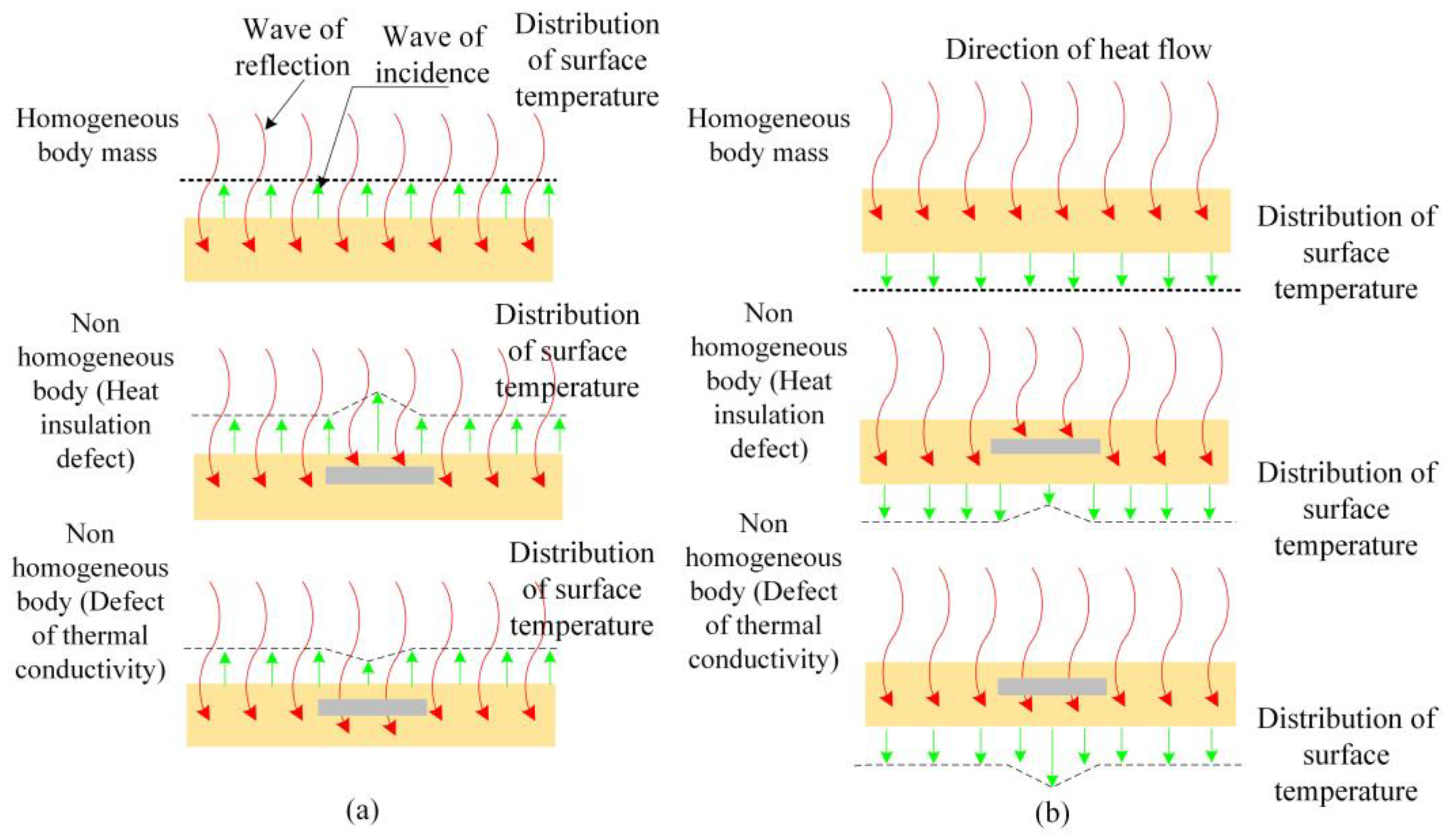
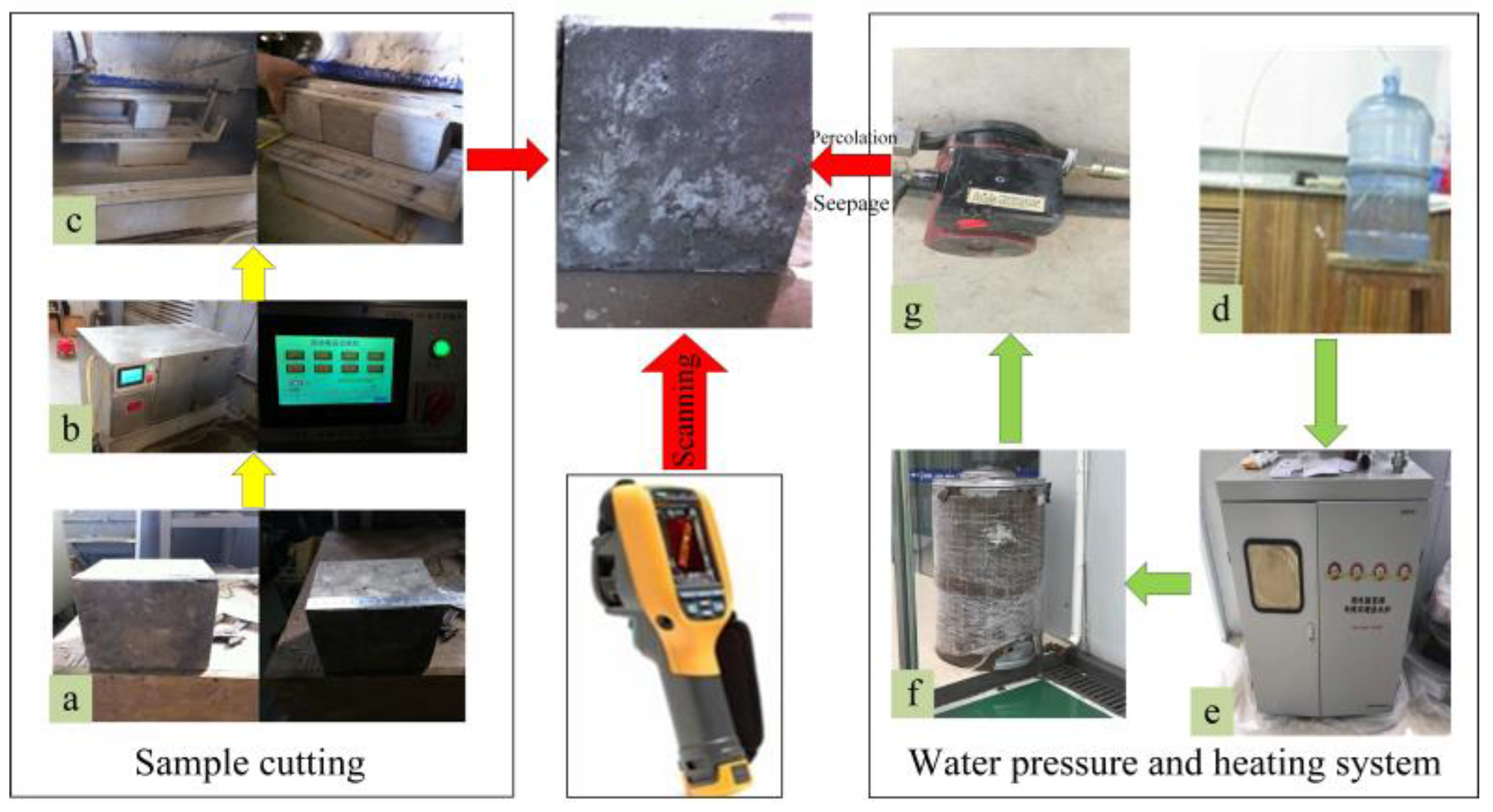
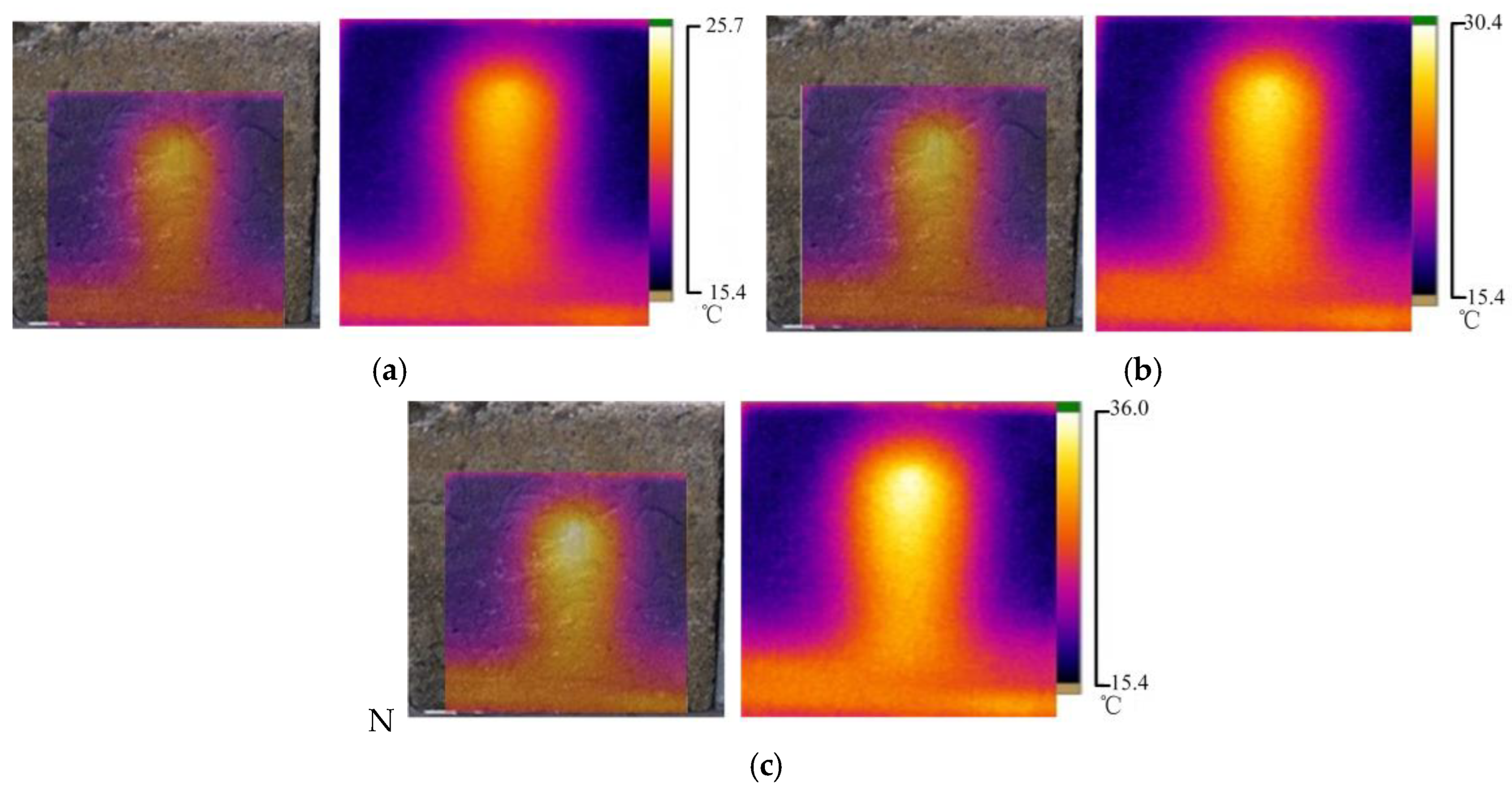
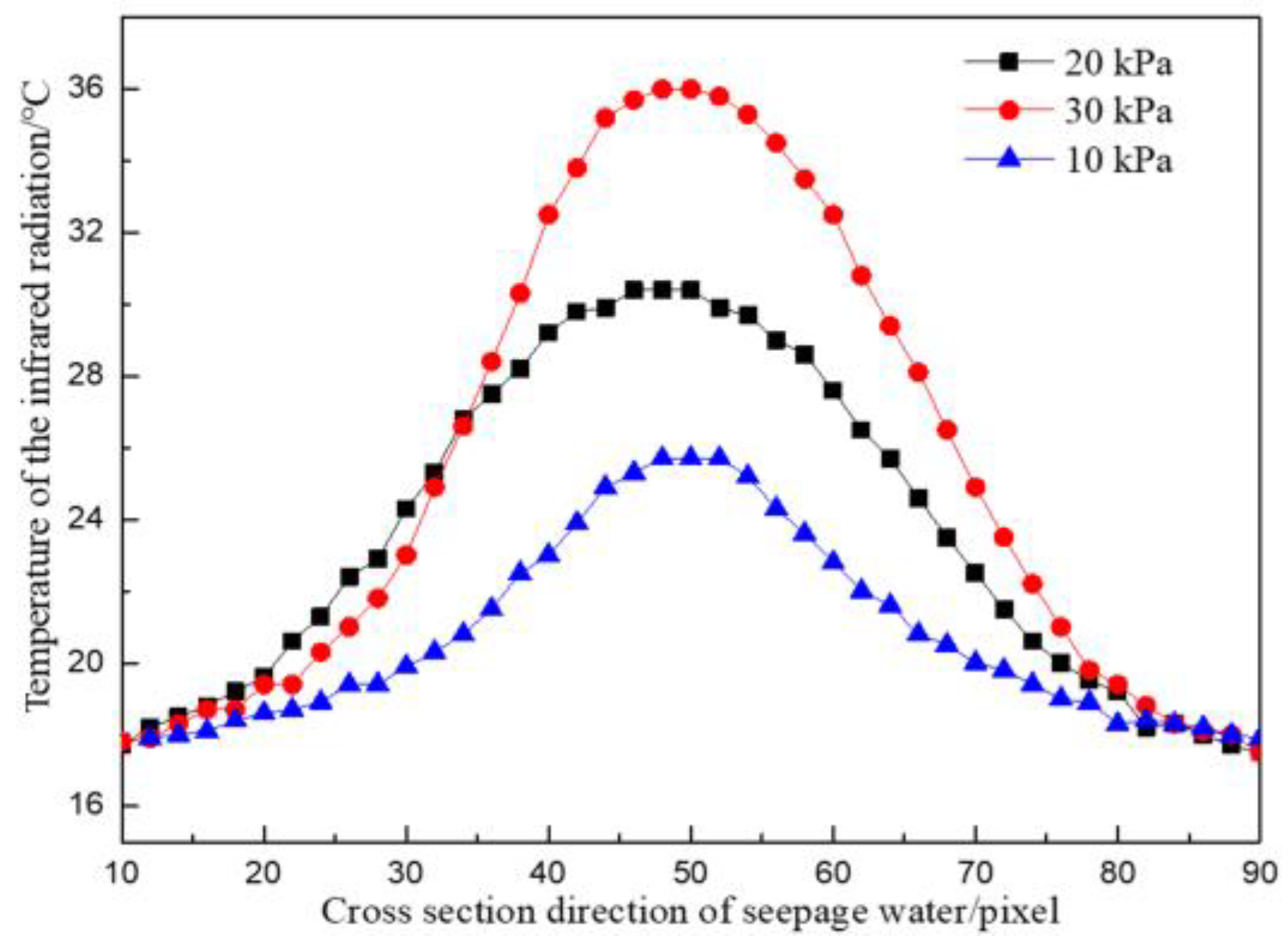
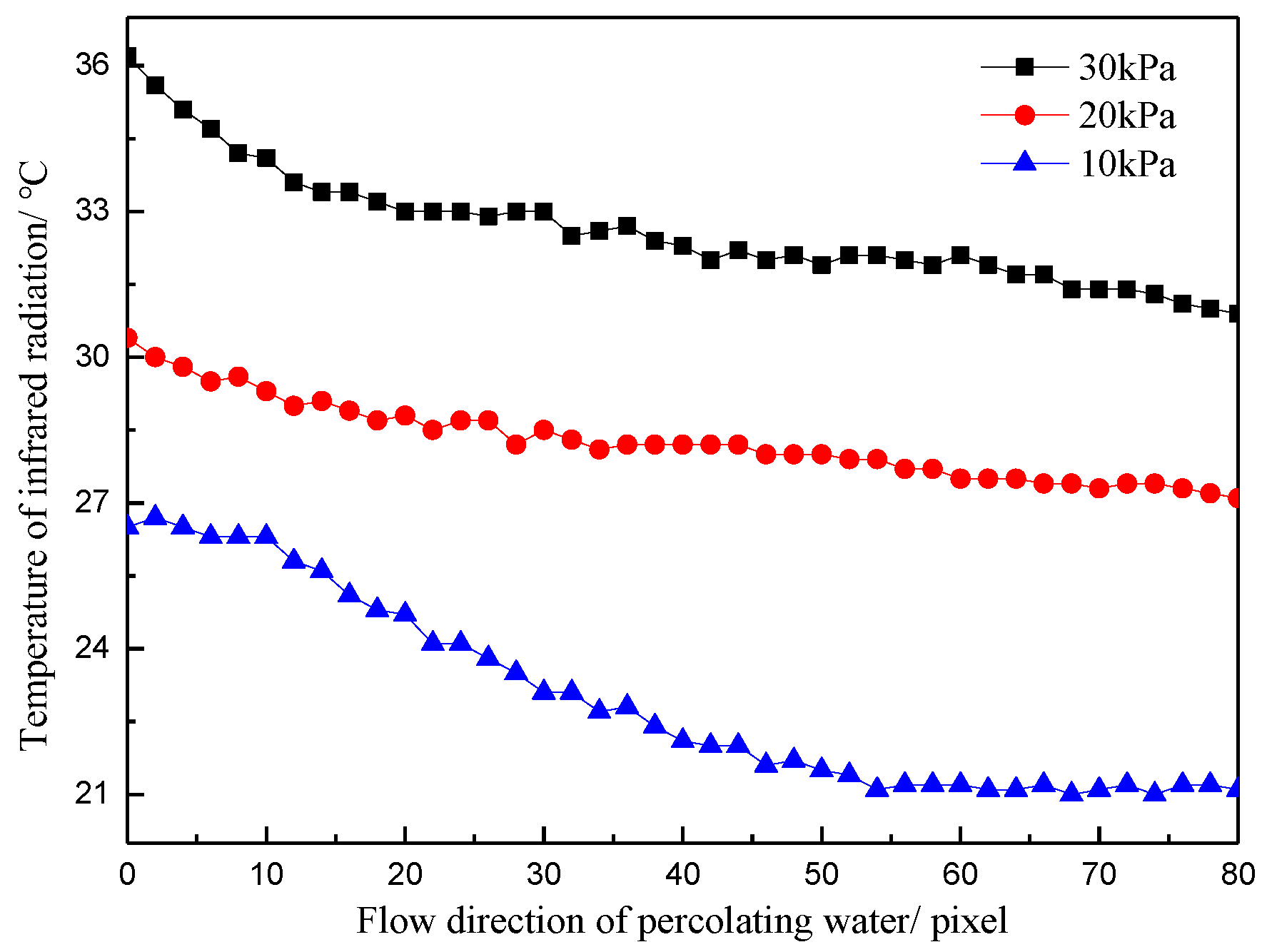

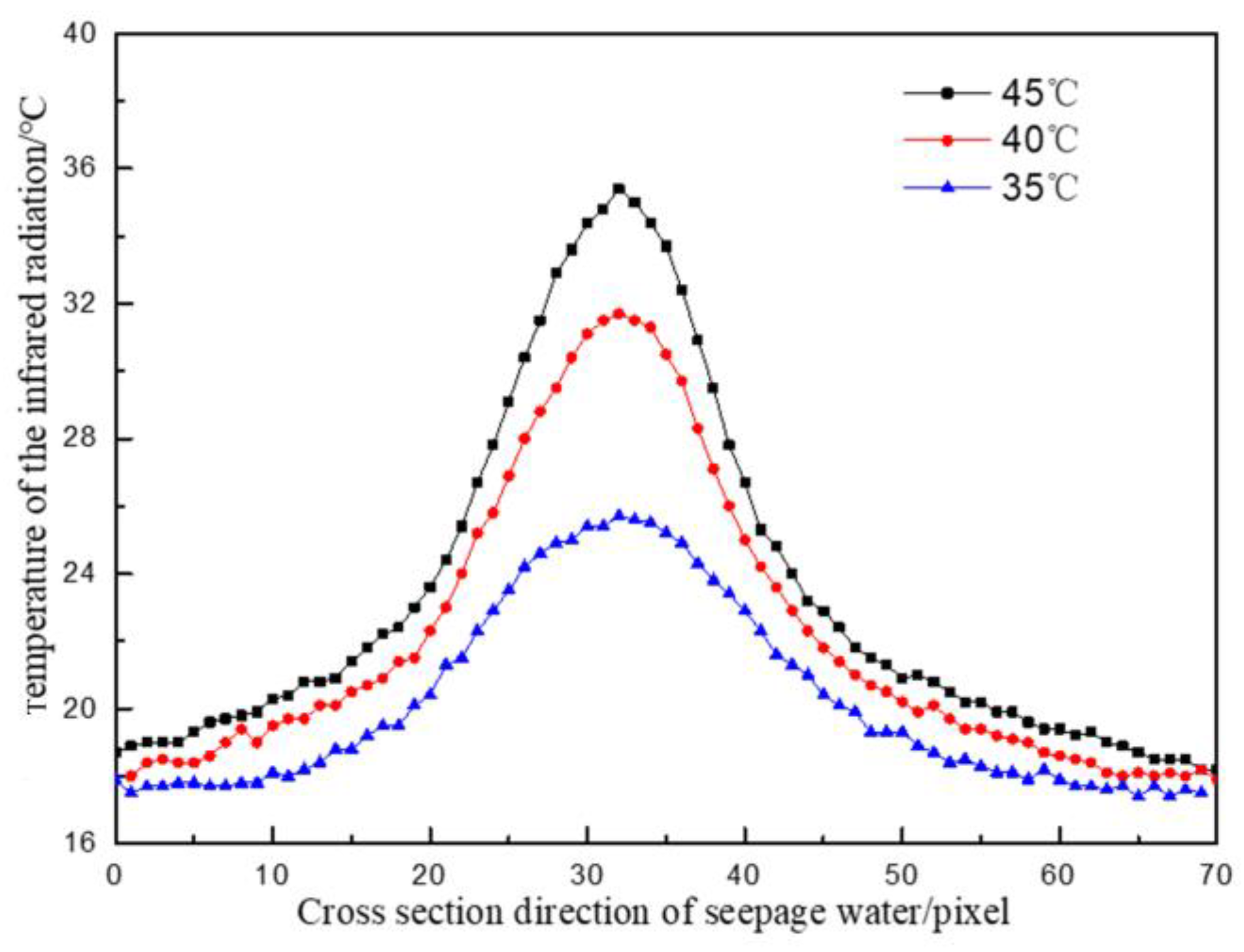
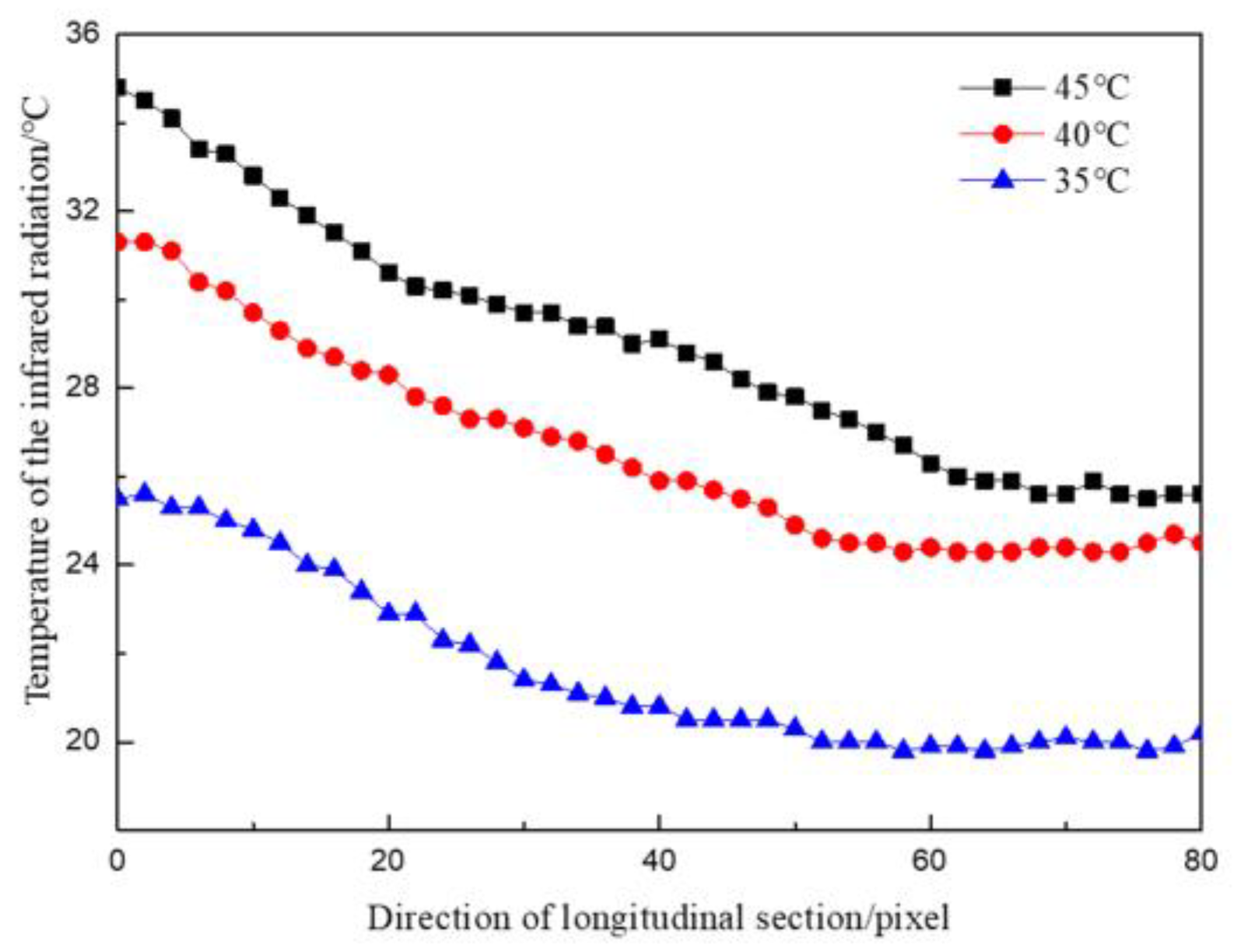

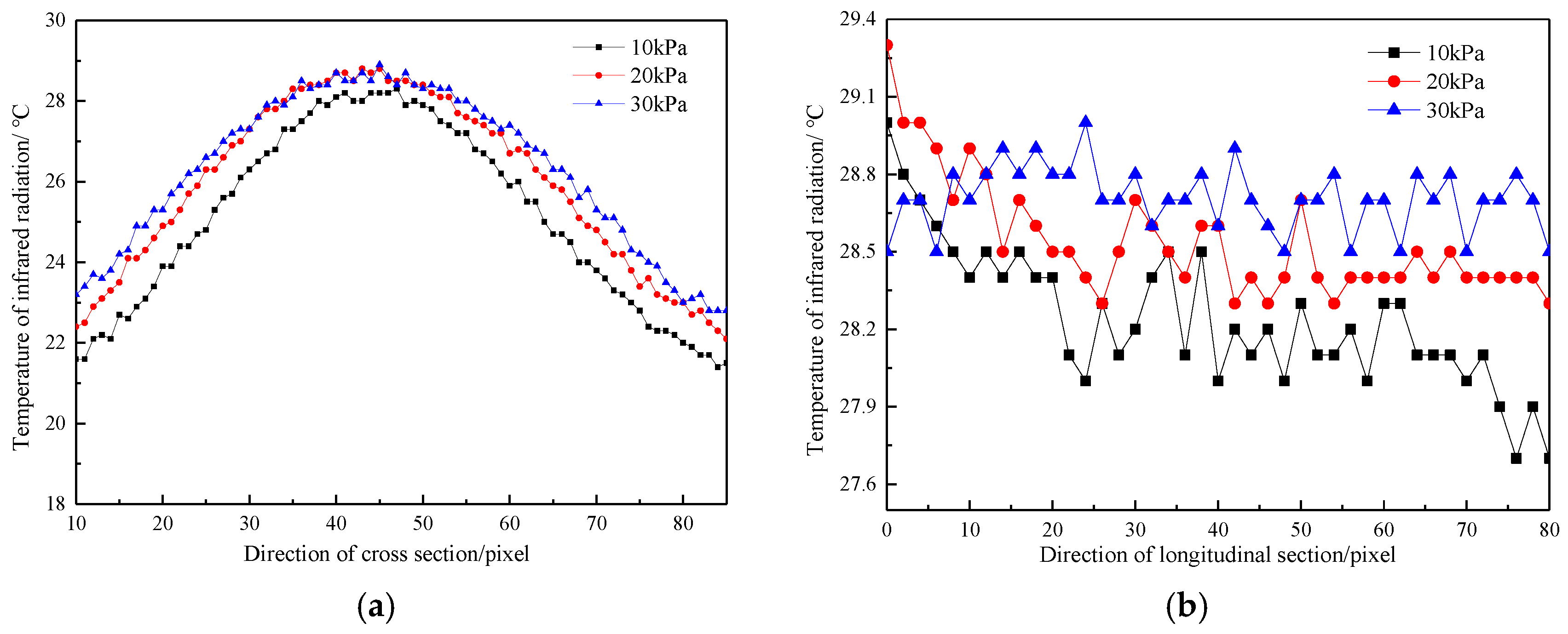
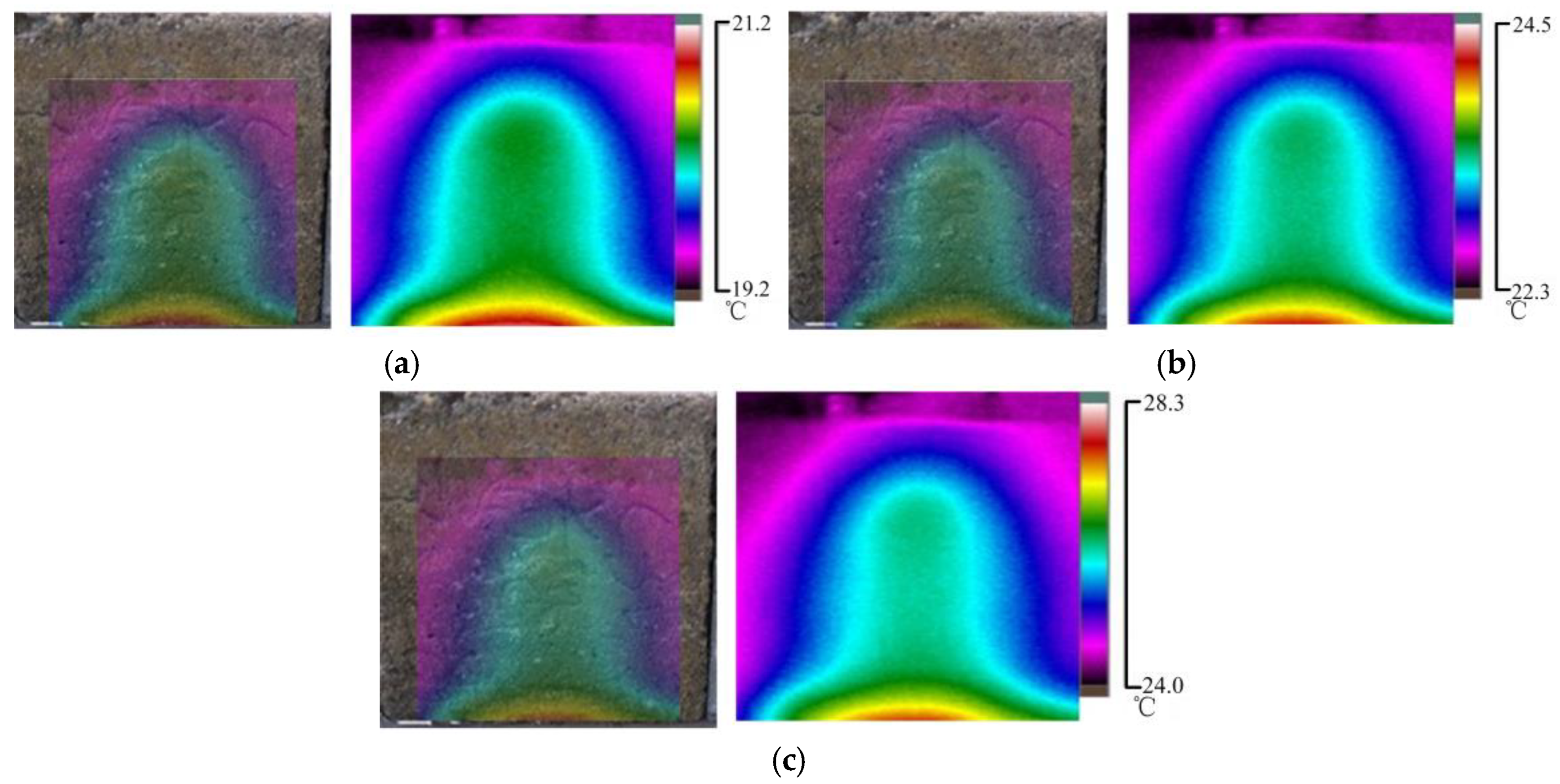
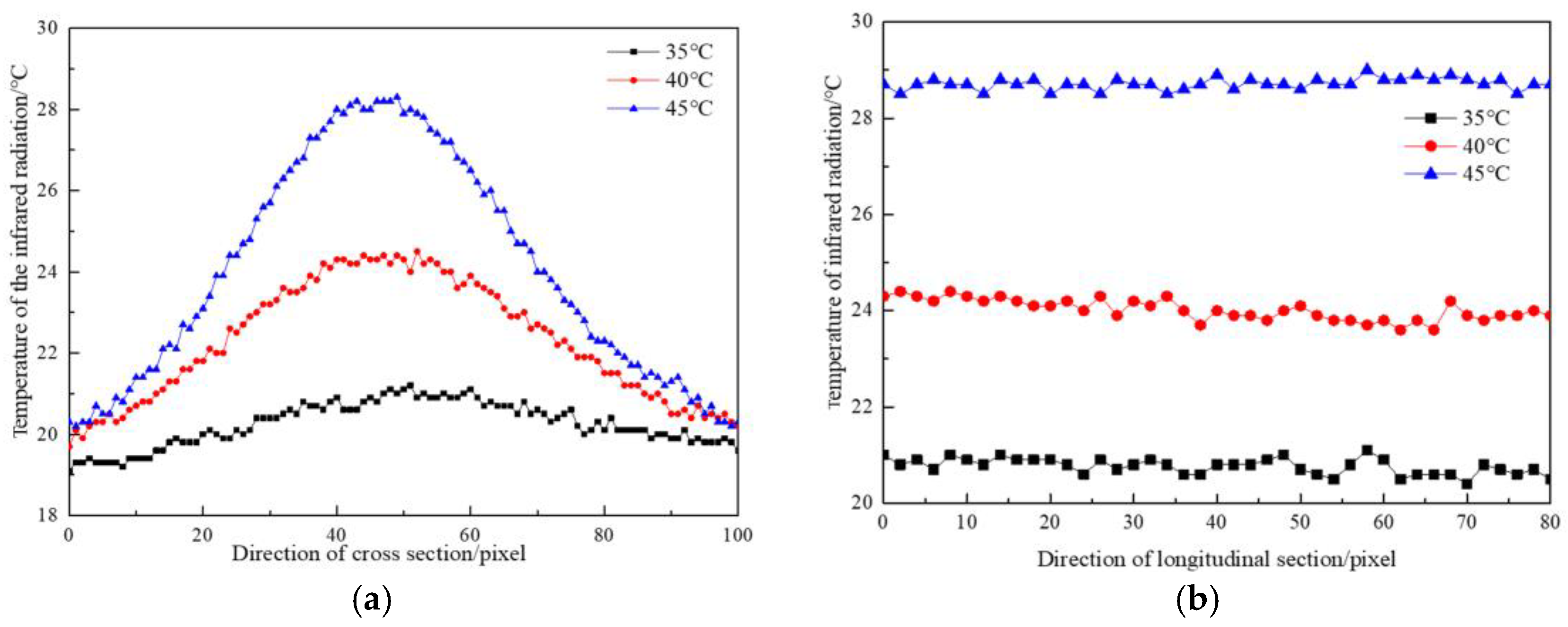
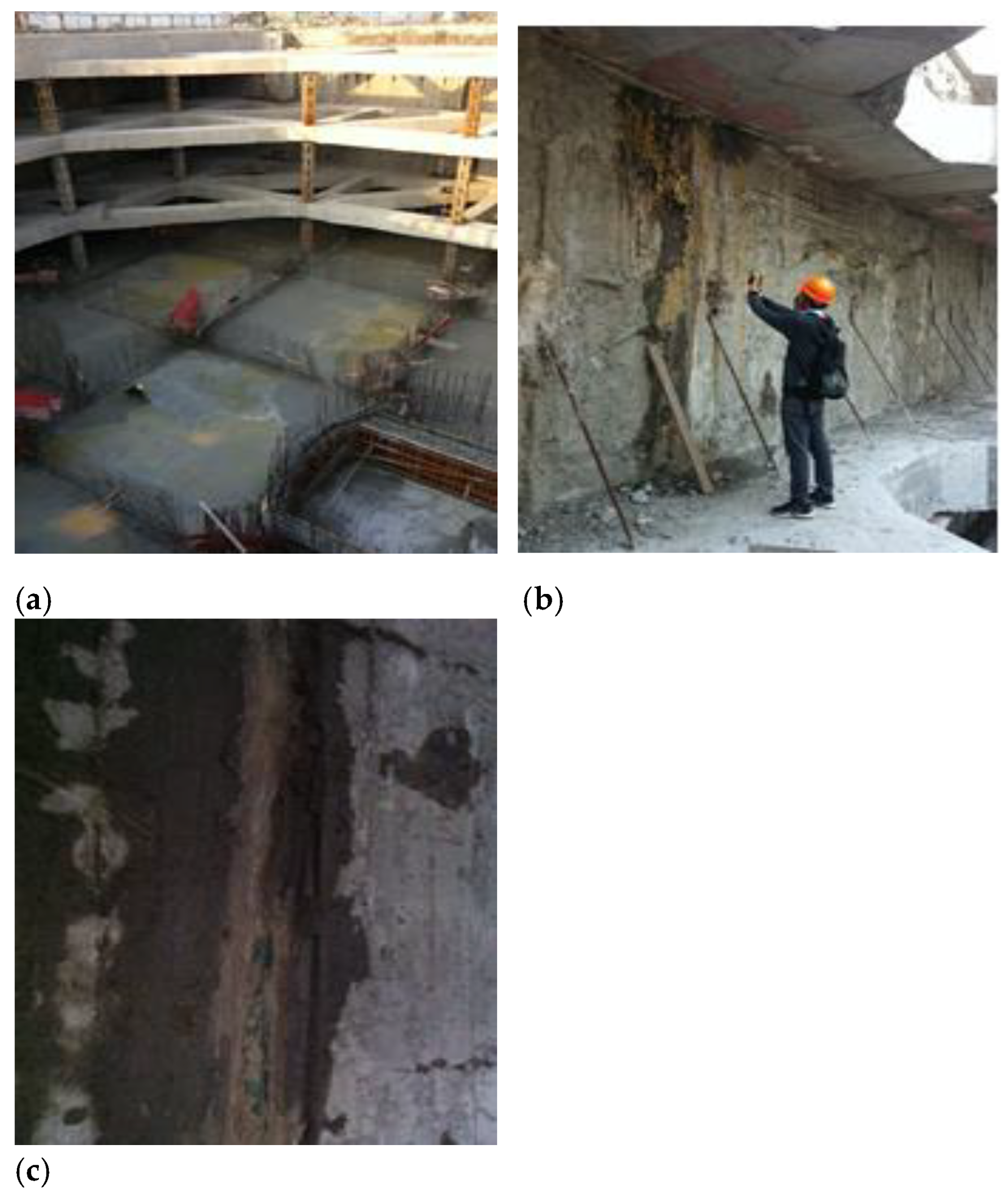
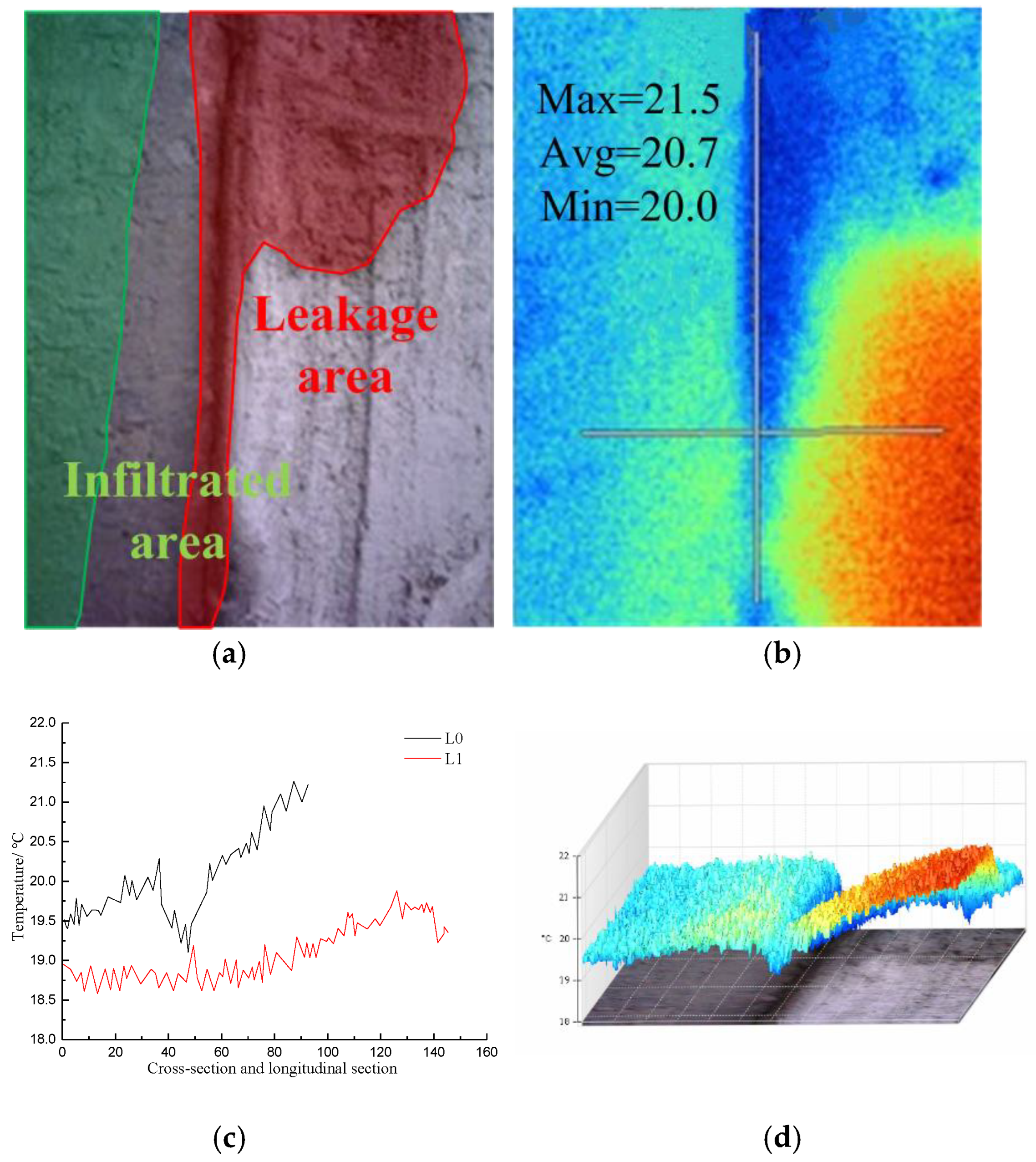
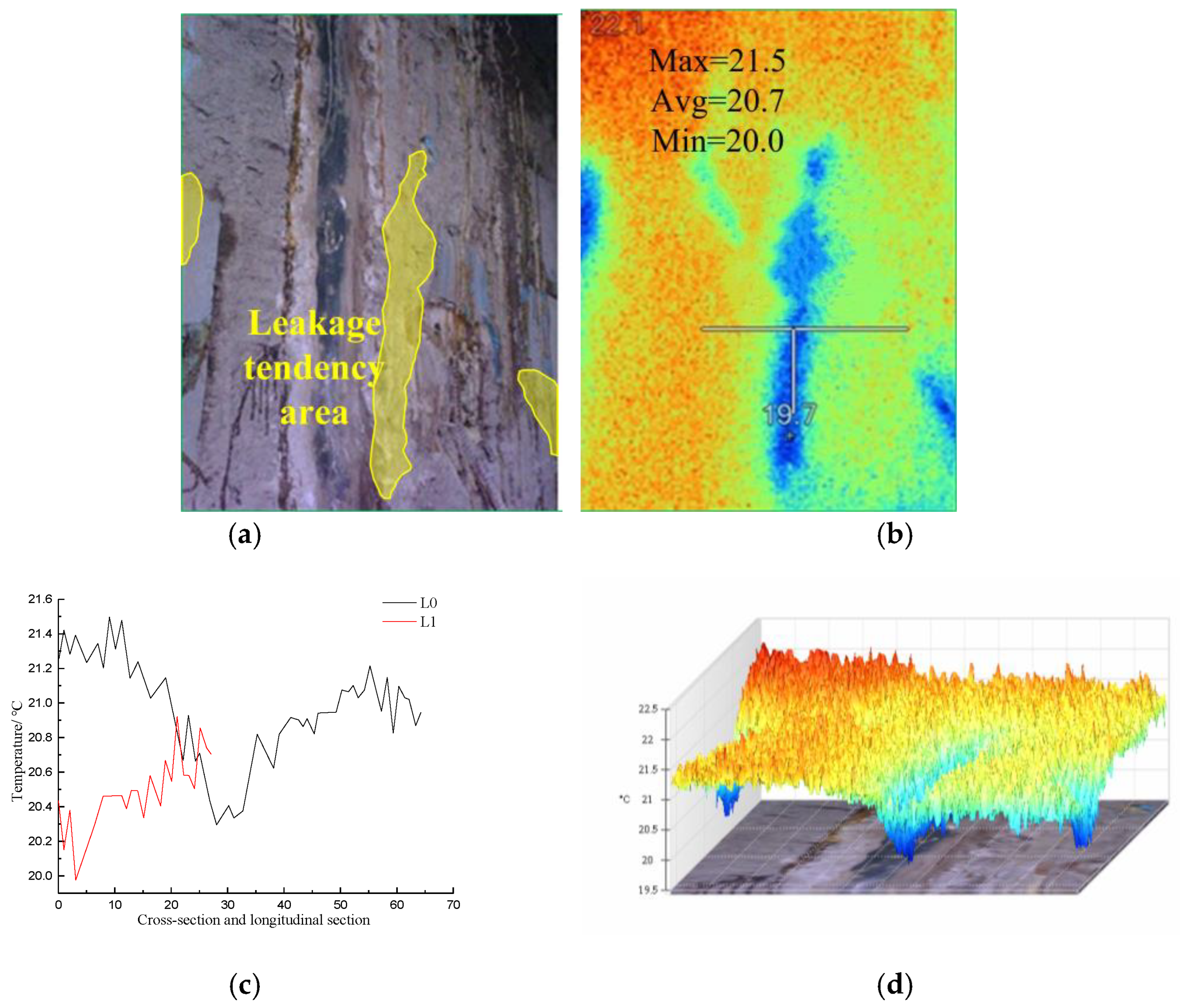
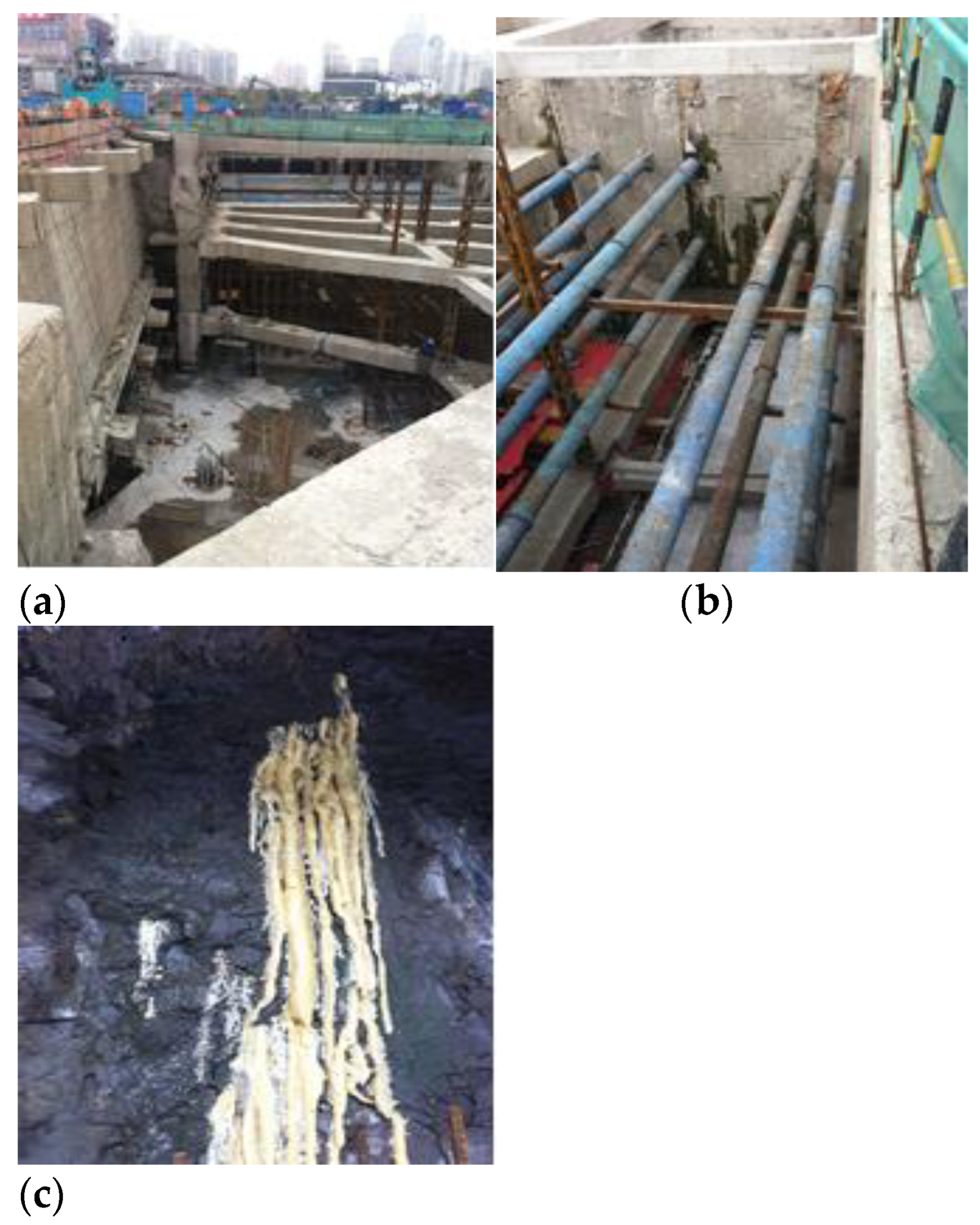


| Simulate the Type of Water Seepage | Control Condition 1 | Condition 2 |
|---|---|---|
| Permeation test | The water temperature is kept at 45 °C | Water pressure is 10 kPa |
| Water pressure is 20 kPa | ||
| Water pressure is 30 kPa | ||
| The water pressure is maintained at 30 kPa | Water temperature is 35 °C | |
| Water temperature is 40 °C | ||
| Water temperature is 45 °C | ||
| Permeation tendency area | The water temperature is kept at 45 °C | Water pressure is 10 kPa |
| Water pressure is 20 kPa | ||
| Water pressure is 30 kPa | ||
| The water pressure is maintained at 30 kPa | Water temperature is 35 °C | |
| Water temperature is 40 °C | ||
| Water temperature is 45 °C |
Disclaimer/Publisher’s Note: The statements, opinions and data contained in all publications are solely those of the individual author(s) and contributor(s) and not of MDPI and/or the editor(s). MDPI and/or the editor(s) disclaim responsibility for any injury to people or property resulting from any ideas, methods, instructions or products referred to in the content. |
© 2023 by the authors. Licensee MDPI, Basel, Switzerland. This article is an open access article distributed under the terms and conditions of the Creative Commons Attribution (CC BY) license (https://creativecommons.org/licenses/by/4.0/).
Share and Cite
Wang, J.; Liu, P.; Hu, J.; Pan, W.; Long, Y.; Cao, A.; Li, H.; Sun, Y. Mechanism of Detecting the Construction Quality of a Diaphragm Wall by an Infrared Thermal Field and Engineering Application. Materials 2023, 16, 1052. https://doi.org/10.3390/ma16031052
Wang J, Liu P, Hu J, Pan W, Long Y, Cao A, Li H, Sun Y. Mechanism of Detecting the Construction Quality of a Diaphragm Wall by an Infrared Thermal Field and Engineering Application. Materials. 2023; 16(3):1052. https://doi.org/10.3390/ma16031052
Chicago/Turabian StyleWang, Jianxiu, Pengfei Liu, Jian Hu, Weiqiang Pan, Yanxia Long, Ansheng Cao, Huboqiang Li, and Yuanwei Sun. 2023. "Mechanism of Detecting the Construction Quality of a Diaphragm Wall by an Infrared Thermal Field and Engineering Application" Materials 16, no. 3: 1052. https://doi.org/10.3390/ma16031052





